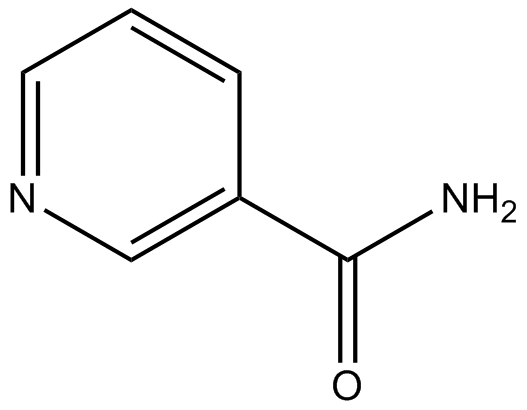Nicotinamide (Vitamin B3) (Synonyms: Niacinamide, Nicotinic Acid Amide, NSC 13128, NSC 27452, Vitamin B3 Amide) |
| Catalog No.GN10347 |
Nicotinamide is an inhibitor of poly(ADP-ribose) polymerase (PARP-1) enzymes.
Products are for research use only. Not for human use. We do not sell to patients.

Cas No.: 98-92-0
Sample solution is provided at 25 µL, 10mM.
IC50: N/A
Nicotinamide is an inhibitor of poly(ADP-ribose) polymerase (PARP-1) enzymes. Poly(ADP-ribose) polymerase-1 (PARP-1) is found as a DNA repair enzyme. The excessive activation of PARP-1, such as ischemia and trauma, can deplete cellular nicotinamide adenine dinucleotide as a substrate and leads to brain cell death eventually.
In vitro: Previous findings suggested that nicotinamide had a protective effect against PARP-1-induced astrocyte death. The transporter-mediated uptake of nicotinamide, which was extracellular pH-sensitive and common to N-methylnicotinamide, was found to be critical for prevention of PARP-1-triggered cell death [1].
In vivo: Type 2 diabetes was induced in Wistar rats by streptozotocin followed by nicotinamide. Test compounds and standard treatment were continued for 15 days. Results showed that there was significant normalisation of liver antioxidant enzymes compared to diabetic rats, suggesting all the tested compounds were beneficial in reducing oxidative stress [2].
Clinical trial: Previous clinical trials showed nicotinamide was well tolerated. Phase 1 showed a dose-response relation for proportional change in frataxin protein concentration. Phases 2 and 3 showed daily dosing resulted in a sustained and significant upregulation of frataxin expression [3].
References:
[1] Suzuki E,Okuda H,Nishida K,Fujimoto S,Nagasawa K. Protective effect of nicotinamide against poly(ADP-ribose) polymerase-1-mediated astrocyte death depends on its transporter-mediated uptake. Life Sci.2010 Apr 24;86(17-18):676-82.
[2] Yogendra Nayak, Venkatachalam Hillemane,Vijay Kumar Daroji,B. S. Jayashree,andM. K. Unnikrishnan. Antidiabetic Activity of Benzopyrone Analogues in Nicotinamide-Streptozotocin Induced Type 2 Diabetes in Rats. Scientific World Journal. 2014; 2014: 854267.
[3] Libri V,Yandim C,Athanasopoulos S,Loyse N,Natisvili T,Law PP,Chan PK,Mohammad T,Mauri M,Tam KT,Leiper J,Piper S,Ramesh A,Parkinson MH,Huson L,Giunti P,Festenstein R. Epigenetic and neurological effects and safety of high-dose nicotinamide in patients with Friedreich's ataxia: an exploratory, open-label, dose-escalation study. Lancet.2014 Aug 9;384(9942):504-13.
Average Rating: 5 (Based on Reviews and 30 reference(s) in Google Scholar.)
GLPBIO products are for RESEARCH USE ONLY. Please make sure your review or question is research based.
Required fields are marked with *




















